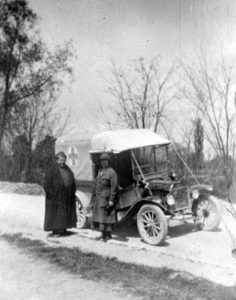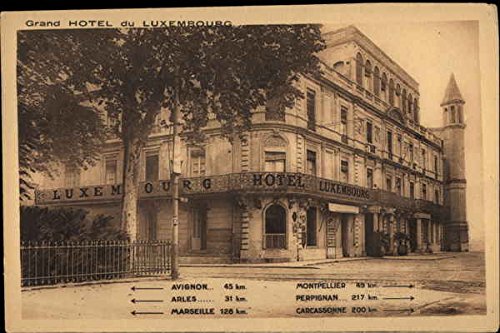Memories are finicky; sometimes accurate, sometimes fuzzy, and sometimes fiction. Among some amusing memories of Stein and Toklas, there is some general mix-up regarding their picnic jaunts during 1917-1918 when they were living in Nimes and working for the American Fund for the French Wounded (A.F.F.W.).
For iconoclasts, Stein and Toklas were old-fashioned when naming their motorcars, the most famous of which were “Auntie” and “Lady Godiva.” These Ford motorcars, the only brand Stein preferred, were used for many picnic jaunts beginning in 1916 and from then on until Stein, the designated driver, could no longer drive.

Stein was the only driver.Beinecke Rare Book and Manuscript Library
“Auntie,” the 1916 Ford truck was purchased by Stein and outfitted at her expense as an ambulance/supply truck for the A.F.F.W. Until Toklas called it “Aunt Pauline” in The Alice B. Toklas Cookbook (1953), the truck was called “Auntie.”
Helping with medical supply distribution for A.F.F.W., Stein and Toklas resided in Nîmes at the Hotel Luxembourg, in March 1917-November 1918. When they could, they whiled their time taking jaunts to neighboring villages in Province: Les Baux Tarascon, Arles, Avignon, among others. Therese was always day trips because Stein did not like to drive at night, and the headlights on their Ford truck were insufficiently bright. Among those treated to trips, whom Stein called “god-sons,” were W.G. Rogers and Samuel Barlow. Each wrote a memoir about motor trips and picnics to the same locations but with different memories about details.
Rogers, a nineteen-year-old soldier, a private first class, met Stein and Toklas in 1917 Nimes while on furlough. Working with an ambulance unit attached to the French army, the U.S. had not yet entered the war. Barlow was twenty-three and sergeant in the U.S. Office of Military Intelligence on leave in Marseille. His narrative is that Stein and Toklas befriended him. He seems not to know Stein’s penchant for calling young men like himself “god-sons.” Rogers’s memoir When This You See Remember Me (1947) remembers the picnics, but not the food, and “Auntie” as a dilapidated motorcar but not a supply truck. “Auntie,” he writes, “looked like an assemblage of parts than one solid piece, it rode high on wooden wheels with bicycle-size tires; a box rather than a hood covered the motor; half of the windshield, which split in the middle horizontally, could be turned up to let in the air on a perspiring driver; the mudguards bent up and forward at anything but a rakish angle; the top above the seat was collapsible.” They had “picnic lunches when the mistral didn’t blow the plates away, or hotel dinner when it did . . . to such gourmets as Miss Stein and Miss Toklas, picnic lunch prepared by Miss Toklas was no anticlimax even to the marvels of the Midi.” Where Toklas might prepare such picnic lunches or buy them ready-made is unclear. It didn’t matter to Rogers, only that he remembered they were good.
Barlow had a letter of introduction to Stein, but it is unknown who wrote it. They met at the hotel, presumably Luxembourg, though he does not say which one. Barlow’s narrative “Ave Dion: A Tribute,” written long after Stein died in 1946, tells another similar yet dissimilar picnic story. Barlow’s memory is that as Stein and Toklas hoarded gas so they could give their young sergeant a Cook’s tour of their favorite sights. He’s sure they started at 7 am, and Toklas had sandwiches and wine. But Barlow does not remember the kinds of sandwich or the wine or how Stein might have come by them. He remembers that they traveled in an ambulance described as a Ford camionette. He sat uncomfortably in the rear on cushions and a soapbox while Stein and Toklas sat up front in the cab. As for his memory, he says that Toklas called the Ford “Lizzy,” not Pauline.
Years later, Toklas’s memory got fuzzy, and in The Alice B. Toklas Cookbook (1953), she forgot Rogers and fictionalized Barlow as an American spy. In Toklas’s narrative, he approached them and explained, “I am Samuel Barlow, and we have several friends in common,” Toklas narrative. Still, I am here as an officer in the secret service, in civvies naturally to find out what is going on between yonder gay blonde and the American officers.”
*Later, William G. Rogers became art editor for the Associated Press and author of several books. Samuel L. Barlow, a pianist, was a composer.
See: Stein Autobiography of A.B.T.; http://gutenberg.net.au/ebooks06/0608711.txt

